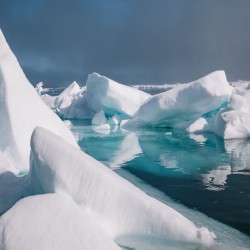Postcards from icy Baffin Bay
Admin February 16, 2024

When I imagine the Arctic the first thing to spring to mind is the ice. A sea of ice.
Life in the far north revolves around the sea ice in every single way. In fact, in Inuktitut and other Inuit dialects all across the Arctic, there are usually at least 100 words for snow and ice. Thick sea ice that lasts for years. The ice crystals that form on the sea just before it freezes. Snow that can be used to ice the sled’s runner. Ice that breaks after its strength has been tested with a harpoon.
Ice is life in the far north. In the summertime, ice dictates where we can go on expedition ships, too. While a lot of sea ice melts in the warmer months, not all. The wind and the tides move the sea ice all around, often blocking in bays and harbors. The thickness and ability to move in it in different types of ships is a real skill. Learning to read these charts is something I’d love to learn. Our ship, the Ocean Endeavour, has a 1B ice class rating, which means it can navigate moderate sea but also might need to rely on an icebreaker.
While I was at sea with Adventure Canada in the Arctic last summer, a real highlight was the sea ice. And there’s nowhere better to see it than in Baffin Bay.
Baffin Bay is a huge stretch of marginal sea between west Greenland and Baffin Island in Canada. Situated above the 70° North parallel, Baffin Bay spans an area of nearly 700,000 square kilometers. And it’s nearly always frozen solid and chocked full of icebergs. Ships cannot pass through in the winter.
I spent a lot of time in Baffin Bay this past summer. Most of Adventure Canada’s Arctic expedition trips pass through or along Baffin Bay at one point or another.
Baffin Bay is a great place to see the iconic sea ice, and we often had to travel along the edges of the pack ice looking for ways through or for paths to open up. I didn’t sleep much on these days because the pack ice is one of the best spots to look for polar bears as they hunt here.
We crossed Baffin Bay between Greenland and Canada a few times, and each trip was magical. And the water was dead calm.
Sea ice often brings down the swells and waves, making it flat. We sometimes stopped in the bay and unloaded the zodiacs to cruise through the pack ice looking for wildlife. Often, the water was like glass, even in the middle of the bay. It was particularly beautiful when fog and mists would move in and out, creating an ethereal feeling.
In the summertime, part of Baffin Bay opens up in the north called North Water, and it’s a polynya (an area of open water surrounded by sea ice) that is around 80,000 square kilometers. It’s really important for its biodiversity; here, in this little microclimate, you’ll find some of the most iconic Arctic animals, such as seals, seabirds, polar bears, walrus, narwhal, beluga, and bowhead whales.
We saw them all
Baffin Bay connects the Labrador Sea and the Davis Strait with the Atlantic Ocean.
First, the Thule and later the Inuit inhabited this area for thousands of years. During their explorations, there is evidence that the Norse also arrived. There are still settlements along the bay today.
The first record of Europeans arriving here was in 1585, with John Davis sailing under Queen Elizabeth I. The British began searching for the mysterious Northwest Passage through Canada that would connect them to the Far East to no avail. The Davis Strait is named after him, a stretch of sea between Baffin Bay to the north and the Labrador Sea to the south.
This was the beginning of the endless searches for the Northwest Passage over centuries. I spent nearly three weeks onboard as we navigated the length of the Northwest Passage; it was one of the coolest experiences of my life.
In the early 17th century, William Baffin explored and charted the area all around Lancaster Sound as a pilot under Henry Hudson. He is considered to be the first European to “discover” Baffin Bay, which is named after him, though they did not find a way through the Northwest Passage.
It wouldn’t be until 1906 that the great Norwegian explorer Roald Amundsen would successfully find a route through the Northwest Passage.
Something that’s important to distinguish when you’re in the Arctic (or Antarctic) is sea ice versus icebergs. We see plenty of both in the Arctic, especially around Baffin Bay.
Sea ice forms in the ocean from saltwater
Sea ice forms in the ocean from saltwater. It is also classified by age and thickness, with multiyear ice being the strongest, having survived multiple summer melts. The water needs to be -1.8°C for the ice to begin to form, and as it ages year after year, the brine in the frozen water disappears, meaning that it turns to frozen freshwater – this was often used by polar expeditions.
Many of the Arctic expeditions involve intentionally getting their ships stuck in the sea ice and overwintering. This has not always ended well. First off, the sea ice will move and drift, taking you away with the currents.
